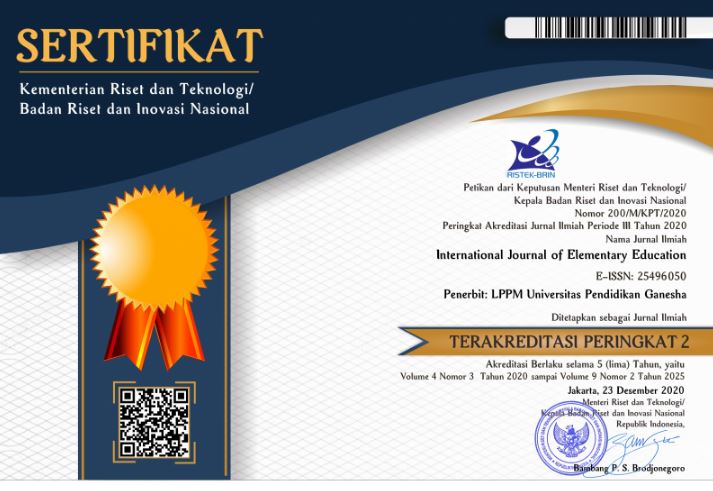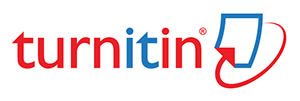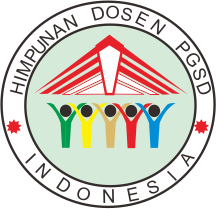Mapping Digital Literacy of Elementary School Teachers in the Era of Digital Native Generation
DOI:
https://doi.org/10.23887/ijee.v8i3.85671Keywords:
Teacher Digital Literacy, Mapping, Digital Native GenerationAbstract
Teachers are currently challenged to adapt to the digital native generation, requiring them to effectively utilize digital technology in designing engaging learning experiences. This study aims to assess the digital literacy levels of elementary school teachers and analyze the relationship between digital literacy and variables such as age, years of service, and employment status. A quantitative research method with a survey approach was employed. The study involved 141 teachers selected through random sampling. Data were collected using a questionnaire instrument comprising four modified digital literacy indicators: internet searching, hypertext navigation, content evaluation, and knowledge assembly. Data analysis was conducted using Microsoft Excel, while correlation testing utilized Spearman’s technique. The findings revealed that the digital literacy of elementary school teachers across four districts was moderately good, as reflected in maximum score presentations at levels 4 and 5. In practice, some teachers were able to design digital teaching materials, though many faced challenges due to inadequate infrastructure support. Correlation tests indicated significant relationships between hypertext navigation, content evaluation, and knowledge assembly with teachers' digital literacy levels. The study concludes that schools should enhance infrastructure support for digital literacy implementation, and teachers need additional training to effectively address the demands of teaching in the digital native era.
References
Anhusadar, L. (2020). Persepsi Mahasiswa PIAUD terhadap Kuliah Online di Masa Pandemi Covid 19. KINDERGARTEN: Journal of Islamic Early Childhood Education, 3(1), 44. https://doi.org/10.24014/kjiece.v3i1.9609.
Anyanwu, R. (2004). Lessons on Plagiarism : Issues for Teachers and Learners. International Education Journal, 4(4), 178–187. http://iej.cjb.net.
Aydin, E., & Erol, S. (2021). The Views of Turkish Language Teachers on Distance Education and Digital Literacy during Covid-19 Pandemic. International Journal of Education and Literacy Studies, 9(1), 60. https://doi.org/10.7575/aiac.ijels.v.9n.1p.60.
Baker, C. N., Peele, H., Daniels, M., Saybe, M., Overstreet, S., & Learning, T. S. (2021). The Experience of COVID-19 and Its Impact on Teachers ’ Mental Health , Coping , and Teaching. School Psychology Review, 0(0), 1–14. https://doi.org/10.1080/2372966X.2020.1855473.
Barth, A., & Tsemach, S. (2023). Empowerment as a Mediator between Instructional Leadership and Teachers’ Organizational Citizenship Behavior. Research in Educational Administration and Leadership, 8(2), 335–371. https://doi.org/10.30828/real.1282746.
Brown, A., & Smolenaers, E. (2016). Parents’ Interpretations of Screen Time Recommendations for Children Younger Than 2 Years. Journal of Family Issues, 39(2), 406–429. https://doi.org/10.1177/0192513X16646595.
Carrillo, C., & Flores, M. A. (2020). COVID-19 and teacher education: a literature review of online teaching and learning practices. European Journal of Teacher Education, 43(4), 466–487. https://doi.org/10.1080/02619768.2020.1821184.
Clark, A. E., Nong, H., Zhu, H., & Zhu, R. (2021). Compensating for academic loss: Online learning and student performance during the COVID-19 pandemic. China Economic Review, 68(January), 101629. https://doi.org/10.1016/j.chieco.2021.101629.
Damanik, S. W. H., Saraswati, R. U., Sarmin, Ratnasari, E., Rahmadhani, A. P., Nurkholillah, N., & Sari, N. I. (2024). Sosialisasi Peran Copywriting di Instagram Untuk Meningkatkan Penjualan Bisnis Pada Peserta Didik SMK El-Amin. Pandawa: Pusat Publikasi Hasil Pengabdian Masyarakat, 2(1), 16–27. https://doi.org/10.61132/pandawa.v2i1.376.
Dhammi, I., & Ul Haq, R. (2016). What is plagiarism and how to avoid it? Indian Journal of Orthopaedics, 50(6), 581–583. https://doi.org/10.4103/0019-5413.193485.
Ezra, O., Cohen, A., Bronshtein, A., Gabbay, H., & Baruth, O. (2021). Equity factors during the COVID ‑ 19 pandemic : Difficulties in emergency remote teaching ( ert ) through online learning. Education and Information Technologies, 7657–7681. https://doi.org/10.1007/s10639-021-10632-x.
Fajrin, N. D., & Wulandari, S. (2021). Kendala dan Solusi Pembelajaran Daring Selama Masa Pandemi Covid-19 di Sekolah Dasar Se-Pulau Madura. BRILIANT: Jurnal Riset Dan Konseptual, 6(4), 874–889. http://dx.doi.org/10.28926/briliant .v6i4.776.
Ghavifekr, S., & Rosdy, W. A. W. (2015). Teaching and Learning with Technology : Effectiveness of ICT Integration in Schools. International Journal of Research in Education and Science (IJRES), 1(2), 175–191. https://www.ijres.net/index.php/ijres.
Gomez-zwiep, S. (2008). Elementary Teachers ’ Understanding of Students ’ Science Misconceptions : Implications for Practice and Teacher Education. J Sci Teacher Educ (Springer Science+Business Media), 11, 437–454. https://doi.org/10.1007/s10972-008-9102-y.
Haleem, A., Javaid, M., Qadri, M. A., & Suman, R. (2022). Understanding the role of digital technologies in education: A review. Sustainable Operations and Computers, 3(May), 275–285. https://doi.org/10.1016/j.susoc.2022.05.004.
Hanafi, Astutik, I., & Adwitiya, A. B. (2020). The Roles of Schools and Teachers in Building Students’ Character in Digital Era: The Students’ Perspective. 477(Iccd), 279–282. https://doi.org/10.2991/assehr.k.201017.061.
Helsper, E. J., & Eynon, R. (2010). Digital natives: Where is the evidence? British Educational Research Journal, 36(3), 503–520. https://doi.org/10.1080/01411920902989227.
Khodabandeh, F., & Jamali, M. (2019). Exploring the Relationship between Teachers’ Creativity, Classroom Management, Age and Gender. Journal of Foreign Language Teaching and Translation Studies, 4(1), 67–88. https://doi.org/10.22034/efl.2019.225247.1027.
Kivunja, C. (2014). Theoretical Perspectives of How Digital Natives Learn. International Journal of Higher Education, 3(1), 94–109. https://doi.org/10.5430/ijhe.v3n1p94.
Kurniawati, N., Maolida, E. H., & Anjaniputra, A. G. (2018). The praxis of digital literacy in the EFL classroom : Digital- immigrant vs digital-native teacher. Indonesian Journal of Applied Linguistics, 8(1), 1–10. https://doi.org/10.17509/ijal.v8i1.11459.
Li, M., & Yu, Z. (2022). Teachers’ Satisfaction, Role, and Digital Literacy during the COVID-19 Pandemic. Sustainability (Switzerland) , 14(3). https://doi.org/10.3390/su14031121.
Linne, J. (2014). Two generations of digital natives. Intercom - RBCC, 37(2), 203–220. https://doi.org/10.1590/1809-5844.
Maryani, E., Nurhaida, I., Aryanti, N. Y., Windah, A., & Purnamayanti, A. (2023). Pemetaan Digital Literacy Competencies Guru Madrasah Aliyah di Bandar Lampung Pada Era Digital Native Generation. Jurnal Evaluasi Dan Pembelajaran, 5(1), 82–93. https://jepjurnal.stkipalitb.ac.id/index.php/hepi/article/view/85.
Nguyen, V. A. (2017). The Impact of Online Learning Activities on Student Learning Outcome in Blended Learning Course. 16(4), 1–21. https://doi.org/10.1142/S021964921750040X.
Potyrała, K., & Tomczyk, Ł. (2021). Teachers in the lifelong learning process: examples of digital literacy. Journal of Education for Teaching, 47(2), 255–273. https://doi.org/10.1080/02607476.2021.1876499.
Purnomo, E., Panu, R. H., & Nadra, W. S. (2023). Kendala Penerapan Pembelajaran Daring pada Mahasiswa di Fakultas Keguruan dan Ilmu Pendidikan Universitas Khairun. Edukasi, 21(3), 542–549. https://doi.org/10.33387/j.edu.v21i3.6202.
Rahayu, R. P., & Wirza, Y. (2020). Teachers ’ Perception of Online Learning during Pandemic Covid-19. Jurnal Penelitian Pendidikan, 20(3), 392–406. https://doi.org/10.17509/jpp.v20i3.29226.
Rambousek, V., Štípek, J., & Vaňková, P. (2016). Contents of Digital Literacy from the Perspective of Teachers and Pupils. Procedia - Social and Behavioral Sciences, 217, 354–362. https://doi.org/10.1016/j.sbspro.2016.02.101.
Salim, F., Purwanto, A., & Lestari, I. (2024). Improving Students’ Science Problem Solving Ability through the Implementation of Problem Based Learning Models Assisted by Animation Media. International Journal of …, 8(2), 269–278. https://doi.org/10.23887/ijee.v8i2.76925.
Sánchez-Cruzado, C., Santiago Campión, R., & Sánchez-Compaña, M. T. (2021). Teacher digital literacy: The indisputable challenge after covid-19. Sustainability (Switzerland), 13(4), 1–29. https://doi.org/10.3390/su13041858.
Shopova, T. (2014). Digital Literacy of Students and Its Improvement at The University. 7(2), 26–32. https://doi.org/10.7160/eriesj.2014.070201.
Singhal, T. (2020). A Review on COVID-19. The Indian Journal of Pediatrics, 924(April), 281–286. https://doi.org/10.1007/s12098-020-03263-6.
Sugiyono. (2012). Metode Penelitian Kuantitatif, Kualitatif, dan R&D. Alfabeta.
Tabor, S. W., & Minch, R. P. M. (2013). Student Adoption & Development of Digital Learning Media: Action Research and Recommended Practices. Journal of Information Technology Education: Research, 12(5), 604–611. https://doi.org/https://doi.org/10.28945/1882.
Wan, N. (2012). Can we teach digital natives digital literacy? Computer & Education, 56(3), 1065–1078. https://doi.org/10.1016/j.compedu.2012.04.016.
Williamson, B., Eynon, R., & Potter, J. (2020). Pandemic politics, pedagogies and practices: digital technologies and distance education during the coronavirus emergency. Learning, Media and Technology, 45(2), 107–114. https://doi.org/10.1080/17439884.2020.1761641.
Winter, M. (2022). Brazilian Digital Learning Strategies During the COVID-19 Pandemic and Their Impact on Socio-Educational Gaps. Current Issues in Comparative Education, 24(2), 123–135. https://doi.org/10.52214/cice.v24i2.9712.
Yolanda, A, P., R, P., M, A., C, H., M, W., R, P., & B, S. (2020). Studi Eksploratif Dampak Pandemi COVID-19 Terhadap Proses Pembelajaran Online di Sekolah Dasar. EduPsyCouns: Journal of Education, Psychology and Counseling, 2(April), 1–12. https://www.researchgate.net/publication/340661871%0AStudi.
Záhorec, J., Hašková, A., & Munk, M. (2019). Teachers’ professional digital literacy skills and their upgrade. European Journal of Contemporary Education, 8(2), 378–393. https://doi.org/10.13187/ejced.2019.2.378.
Downloads
Published
How to Cite
Issue
Section
License
Copyright (c) 2024 Eko Purnomo; Darmawati; Wawan S. Nadra

This work is licensed under a Creative Commons Attribution-ShareAlike 4.0 International License.
Authors who publish with the International Journal of Elementary Education agree to the following terms:
- Authors retain copyright and grant the journal the right of first publication with the work simultaneously licensed under a Creative Commons Attribution License (CC BY-SA 4.0) that allows others to share the work with an acknowledgment of the work's authorship and initial publication in this journal.
- Authors are able to enter into separate, additional contractual arrangements for the non-exclusive distribution of the journal's published version of the work (e.g., post it to an institutional repository or publish it in a book), with an acknowledgment of its initial publication in this journal.
- Authors are permitted and encouraged to post their work online (e.g., in institutional repositories or on their website) prior to and during the submission process, as it can lead to productive exchanges, as well as earlier and greater citation of published work. (See The Effect of Open Access)








